I'm considering some complex 1-dimensional/real 2-dimensional orbifolds that I expect to be hyperbolic. However, some of them seem to be Euclidean or spherical. Any thoughts what's going on here? Here is the context:
In his paper Shapes of Polyhedra, Thurston considers the moduli space of nonnegatively curved flat cone metric on $S^2$ with $m$ cone points of specified curvatures/angle defects. This moduli space has the structure of a complex hyperbolic manifold (or orbifold) of complex dimension $m-3$. He also explains that the complex hyperbolic metric is typically incomplete. The points added in the completion correspond to classes of cone metrics with fewer cone points arising from the collision of two or more cone points out of the original $m$ whose curvatures sum to less than $2\pi$. For the points in the real codimension-2 strata, where two cone points collide, Thurston's proposition 3.5 explains how to find the cone angle around the stratum. When all cone angles are integer submultiples of $2\pi$, the completion of the moduli space is a complex hyperbolic orbifold.
For metrics with $m=4$ cone points, the moduli space has a $\mathbb{CH}^1 \approx \mathbb{RH}^2$ structure, so we can actually see what's going on. Consider this example:
Example: flat cone metrics with curvatures $\frac{2\pi}{10} \cdot (2,6,6,6)$ (cone points with identical curvatures are unordered). The modular orbifold is a $(2,3,\infty)$ turnover. In the Thurston setting, we complete the moduli space with a single point corresponding to the collision of a $2/10$ cone point and a $6/10$ cone point. Thurston says that the cone angle around that added point in the complex hyperbolic metric is $$2\pi - \left(\frac{2\pi \cdot 2}{10} + \frac{2\pi \cdot 6}{10}\right) = 2\pi \cdot \frac{2}{10} = \frac{2\pi}{5}.$$ So then the completed orbifold is a $(2,3,5)$ turnover. But this a spherical orbifold, not a hyperbolic one. Any idea what's going wrong?
I imagine this has something to do with the fact that a collision of a $2/10$ and a $6/10$ cone point is sort of the same as the collision of the remaining cone points $6/10$ and $6/10$. These two can be swapped with a half twist giving cone angle $\pi - 2\pi \cdot \frac{6}{10} = -\frac{2\pi}{10}$. This is kind of strange though because you cannot bring together two $6/10$ cone points in finite distance in the moduli space, and the cone angle you get from this half twist is negative. Still though, the $(2,3,10)$ turnover is hyperbolic. That would perhaps address my apparent issue.
Thurston, William P., Shapes of polyhedra and triangulations of the sphere, The Epstein Birthday Schrift, Geom. Topol. Monogr. 1, 511-549 (1998).

